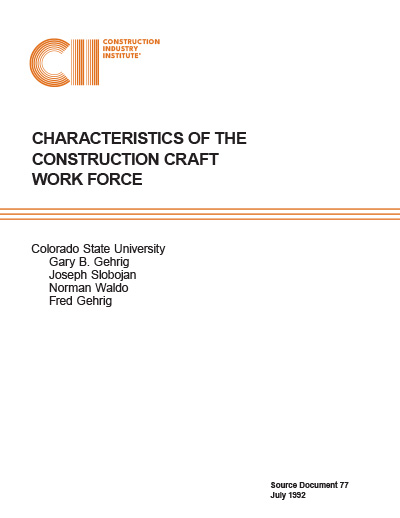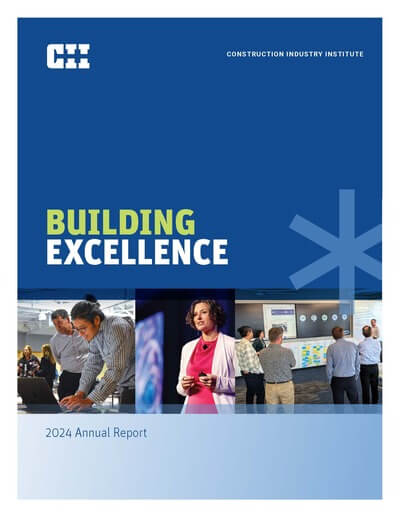
Characteristics of the Construction Craft Work Force
The construction industry faces a stern challenge over the next decade to maintaining a highly skilled and competitive craft work force. The challenge to the industry comes from many fronts not previously encountered and stemming from the changing characteristics of the United States’ demographic composition, economic, social, technological, organizational, managerial, and world political influences.
This study was limited to an investigation of the characteristics of the construction craft work force in the year 2000 as influenced by the above factors, a prediction of the insufficiencies probable in the work force 2000, and subsequent recommendations to negate the insufficiencies to maintain a work force of sufficient size and skills to meet the needs of the industry in 2000.
The demographics of the national labor force is undergoing significant changes as documented in many recent studies conducted by both governmental and private entities. The number of 18-year-olds entering the work force will continue a slow decline over the next 20 years interrupted by brief baby boom rises—the end result being approximately 12 million fewer new entrants into the labor force by 2000. Even with this reduced number of new entrants, there appears to be an adequate supply of workers to meet the needs of the United States goods-producing sector of the economy. There are several factors that are viewed to offset the decline. The predicted shift in the U.S. economy from a product-oriented economy to a service-oriented economy is occurring at a much slower rate. The manufacturing, mining, and agriculture areas of the goods-producing sector of the economy are predicted to decline, thus lessening the competition for product-oriented workers. The manufacturing industry has already announced sizable work force reductions as they restructure for the next decade. The military has announced a 30 percent reduction in strength also lessening competition for the new 18-year-old entrants. Civilian workers now employed at military bases scheduled for closure will be entering the labor force. Additionally the construction industry had predicted a need for about 28.6 billion in construction activity during the 1990s located in the southeast and southern states. This forecast has now been tempered by a slowing economy, tight money markets and cautious attitudes of the owners. The U.S. Department of Labor predicts the construction industry will have a steady growth rate of 1.2% throughout the 1990s. No significant expansion or boom years are envisioned within this decade.
Even with a sufficient supply of crafts, the construction industry will experience job site and regional shortages. Mismatch of skills with required tasks, skills in wrong geographic locations, lack of training for high technology tasks, immobility of craftpersons, poor image, inadequate benefits, and lack of career and professional development are some of the insufficiencies identified as barriers to maintaining a highly skilled and competitive work force.
Researchers conducting studies on the craft work force predict the construction industry must attract 8% of the new entrants per year into the work force and recruit an estimated 200,000 to 250,000 new workers per year to adequately staff the job sites in the late 1990s. To attract these numbers from an adequate national labor pool will be a challenge for the construction industry. Young people, about to enter the labor force, view construction craft work as dirty, non-technical, and non-professional. Although the internal image of a craft career is favorable, the external image is poor. Craftpersons typically leave the craft work force at age 36 which creates another insufficiency as the average age of the national labor force continues to rise beyond 39 years old.
The percentage of minorities and women in the national labor force will continue to increase. The white male population will continue to dominate but will decline from 45 to 42 percent by 2000. As the percent of minorities and women increases in the total labor force, the percent of minorities and women in the construction crafts remains constant. Minorities and women are under utilized and under represented in the crafts and in supervisory positions. Craft training programs for women are operating across the country. Training programs specifically designed for Blacks and Hispanic populations are rare.
The characteristics of the work force indicates that the workers will be lacking basic education skills and skills training. Apprenticeship training programs are now providing and will continue to provide basic education in math, reading and writing along with craft skill training.
The construction industry must consolidate its efforts to recruit, induct, train, and retain construction craftpersons. Fragmented efforts of today are short term solutions. A long term formula to negate insufficiencies is needed. The “Construction Craft Work Force Insufficiencies Negation Scheme” (Construction/WINS) proposed with this study provides a structural framework for industry action. The industry need not create new programs. Optimization of existing thought will provide the methods and techniques to provide a highly skilled and competitive construction craft work force for the future.
The construction craft situations of today and the predicted craft work force characteristics of the next decade demand strategic planning and industry actions today, not tomorrow.
The construction industry must attract 8% of new entrants per year into the work force and recruit an estimated 200,000 to 250,000 new workers per year to adequately staff job sites in the late 1990s. In order to do this, the construction industry must have a better image and seen more favorably for young people; as it is seen as dirty, non-technical, and non-professional. (SD-77, p. 10)
The percentage of minorities in the labor force will continue to increase. Minorities are under utilized and under represented in the crafts and supervisory positions. Craft training programs specifically for the black and Hispanic populations are rare. (SD-77, p. 109)
The work force lacks basic education skills and skills training. Apprenticeship training programs are now providing and will continue to provide basic education in math, reading, and writing along with craft skill training. (SD-77, p. 131)
The construction industry must consolidate its efforts to recruit, induct, train, and retain construction crafts persons. Fragmented efforts of today are short-term solutions, and the industry must optimize existing programs, not develop new ones. (SD-77, p. 91)
Much of the difficulty in predicting what will occur in the construction industry is the uncertainty that exists in the industries that construction serves. Being a service-oriented business, construction depends on the needs of others and generates little new business within itself. Therefore, a look at the total economic projections for the US is necessary to gain insight into what might occur in the construction sector. (SD-77, p. 25)
Predicted trends in the labor workforce that affects construction:
- Lower birth rates of the baby-bust generation cause a reduction in one of six available new entrants to the work force as compared to the 1970s and 1980s.
- Women will make up almost two-thirds of the new labor force by 2000.
- Minorities will provide new entrants at nearly double the current rate and will account for more than 29% of the new entrants.
- Immigrants will represent a large share of the increase in the US population.
There is not a shortage of workers, but there is a multitude of insufficiencies which must be addressed by the industry if it is to be competitive through its workforce: low education levels, lack of needed skills, skilled people located outside of area of need, low wages, poor industry image, less mobile workforce, mismatch of skills with required tasks. (SD-77, p. 41)
SD-77, Construction Work Force Insufficiencies Negation Scheme
This scheme outlines a to monitor the conditions of the industry and prompt the industry to close the gap in skilled craft workers. This scheme is broken into four phases: (SD-77, p. 159)
- Monitoring Phase
- Inquiry/Analysis Phase (Needs Assessment)
- Acquisition Phase Negation Schemes
- Input to Labor Force
- Then return to the Monitoring Phase in an ongoing effort
An overview of the basic elements of the program include:
- Develop Industry Coordinating Council
- Task/Skill Certification Program
- Regional Training Centers
- Cadre of Trainers
- Regional Housing Centers



